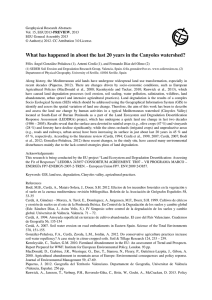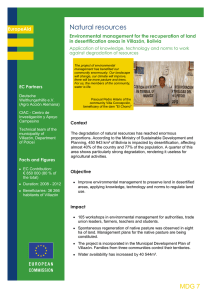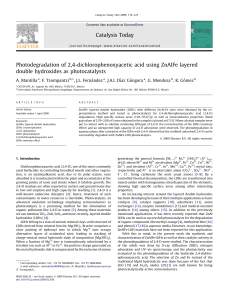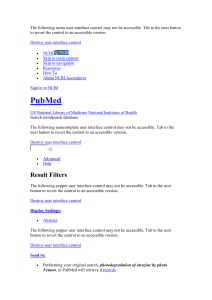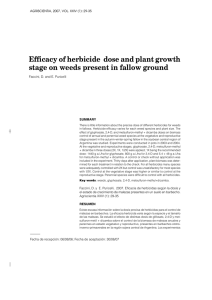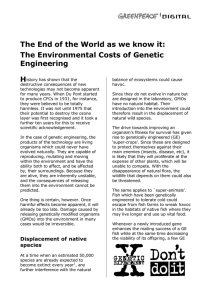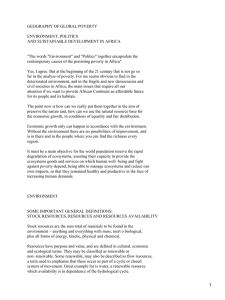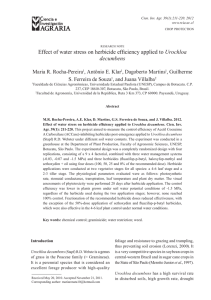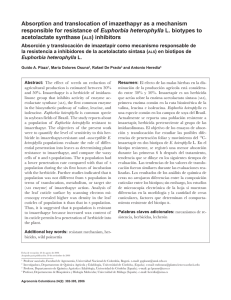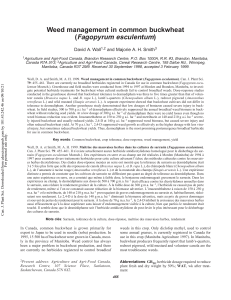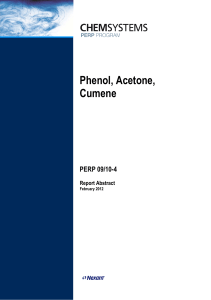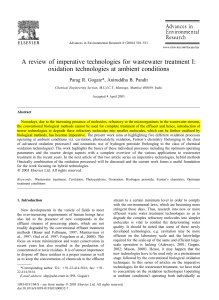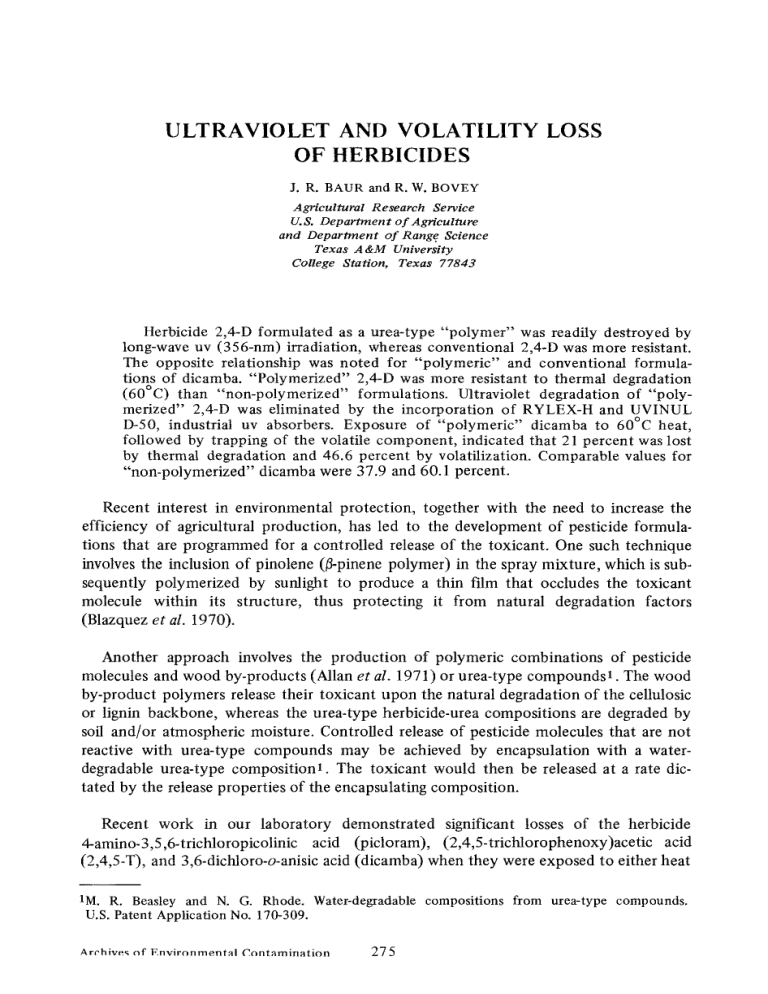
ULTRAVIOLET AND VOLATILITY LOSS OF HERBICIDES J. R. BAUR and R. W. BOVEY Agricultural Research Service U.S. Department o f Agriculture and Department o f Range Science Texas A &M University College Station, Texas 77843 Herbicide 2,4-D formulated as a urea-type "polymer" was readily destroyed by long-wave uv (356-nm) irradiation, whereas conventional 2,4-D was more resistant. The opposite relationship was noted for "polymeric" and conventional formulations of dicamba. "Potymerized" 2,4-D was more resistant to thermal degradation (60°C) than "non-polymerized" formulations. Ultraviolet degradation of "potymerized" 2,4-D was eliminated by the incorporation of RYLEX-H and UVINUL D-50, industrial uv absorbers. Exposure of "polymeric" dicamba to 60°C heat, followed by trapping of the volatile component, indicated that 21 percent was lost by thermal degradation and 46.6 percent by volatilization. Comparable values for "non-polymerized" dicamba were 37.9 and 60.1 percent. Recent interest in environmental protection, together with the need to increase the efficiency of agricultural production, has led to the development of pesticide formulations that are programmed for a controlled release of the toxicant. One such technique hlvolves the inclusion of pinolene (13-pinene polymer) in the spray mixture, which is subsequently polymerized by sunlight to produce a thin film that occludes the toxicant molecule within its structure, thus protecting it from natural degradation factors (Blazquez et al. 1970). Another approach involves the production of polymeric combinations of pesticide molecules and wood by-products (Allan et al. 1971) or urea-type compounds1. The wood by-product polymers release their toxicant upon the natural degradation of the cellulosic or lignin backbone, whereas the urea-type herbicide-urea compositions are degraded by soil and/or atmospheric moisture. Controlled release of pesticide molecules that are not reactive with urea-type compounds may be achieved by encapsulation with a waterdegradable urea-type composition1. The toxicant would then be released at a rate dictated by the release properties of the encapsulating composition. Recent work in our laboratory demonstrated significant losses of the herbicide 4-amino-3,5,6-trichloropicolinic acid (picloram), (2,4,5-trichlorophenoxy)acetic acid (2,4,5-T), and 3,6-dichloro-o-anisic acid (dicamba) when they were exposed to either heat 1M. R. Beasley and N. G. Rhode. Water-degradable compositions from urea-type compounds. U.S. Patent Application No. 170-309. Arehiveq of Environmental Contamination 275 276 J . R . Baur and R. W. Bovey (60°C) or long-wave (356-nm) ultraviolet (uv) irradiation (Baur et al. 1973). During the course of the previous studies (Baur et al. 1973), it became apparent that volatility losses could constitute a large part of what appeared to be thermal degradation, especially of dicamba. Herbicide losses by volatilization have been documented for several nonester herbicides, including ~,~,a-trifluoro-2,6-dinitro-N,N-dipropyl-p-toluidine (trifluralin) (Ketchersid et aL 1969); 2,6-dichlorobenzonitrile (dichlobenil) (Parochetti et al. 1971); 3-(3,4-dichlorophenyl)-l-methoxy-l-methylurea (linuron); and 2-chloro-4-(ethylamino)6-(isopropyl-amino)-s-triazine (atrazine) (Walker 1972). The objectives of this research were (a) to examine the effects of heat and long-wave uv irradiation on the urea-type compositions of (2,4-dichtorophenoxy)acetic acid (2,4-D) and dicamba; and (b) to separate thermal degradation losses from volatility losses for the urea-type compositions and conventional acid formulations of dicamba. The urea-type compositions developed by Beasley and RhodO have polymeric characteristics, although it is not possible at this time to assert unequivocally that they are true polymers. Melting-point data, along with molecular-weight determinations, strongly indicate polymeric structures. The molecular-weight data suggest that the urea-type compositions consist of urea-herbicide units linked into chains whose molecular weight approaches 5,0002. Throughout this report we refer to the urea-type composition as "polymer" with the knowledge that it may be a true polymer or simply a unique combination of components that result in altered herbicidal and degradative characteristics. Reference to conventional formulation refers to solutions of "non-polymerized" 2,4-D or dicamba. Materials and m e t h o d s Solutions. Analytical grade (100% purity) 2,4-D and technical grade (89.3% purity) dicamba were used in all experiments. Except where specifically noted, all experiments were carried out with acetone solutions of the respective herbicides. Urea-type "polymers" of dicamba or 2,4-D were prepared by dissolving 0.1 mole of herbicide plus 0.1 mole of urea in approximately 100 ml of acetone with gentle heat. When the temperature reached 50°C, 25 ml of acetone containing approximately ten drops of concentrated H 2 S O 4 w a s added along with 0.2 mole of trans-cinnamaldehyde. The mixture was stirred gently and heated to 125°C, at which time it was removed from the hot plate, allowed to cool, and diluted to one liter with acetonO. "Non-polymerized" (conventional) solutions consisted of 0.1M herbicide in acetone. Effects of ultraviolet absorbers of the benzophenone and benzotriazole classes on uv losses of "polymeric" and conventional 2,4-D (5 X 10-4M) w e r e conducted with acetone solutions containing three levels (0.1, 0.5, and 1.0% w/v) of five ultraviolet absorbers (Table I). 3 2Personal communication with M. R. Beasleyand N. G. Rhode. 3Mention of a trademark name or proprietary product does not constitute a guarantee or warranty of the product by the U.S. Department of Agriculture or Texas A&M University and does not imply their approval to the exclusion of other products that also may be suitable.
